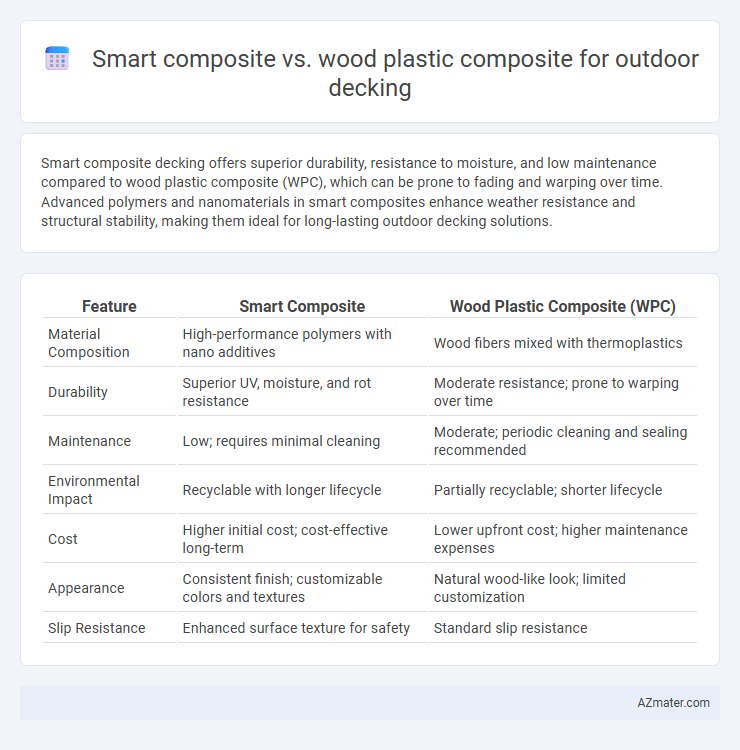Smart composite decking offers superior durability, resistance to moisture, and low maintenance compared to wood plastic composite (WPC), which can be prone to fading and warping over time. Advanced polymers and nanomaterials in smart composites enhance weather resistance and structural stability, making them ideal for long-lasting outdoor decking solutions.
Table of Comparison
| Feature | Smart Composite | Wood Plastic Composite (WPC) |
|---|---|---|
| Material Composition | High-performance polymers with nano additives | Wood fibers mixed with thermoplastics |
| Durability | Superior UV, moisture, and rot resistance | Moderate resistance; prone to warping over time |
| Maintenance | Low; requires minimal cleaning | Moderate; periodic cleaning and sealing recommended |
| Environmental Impact | Recyclable with longer lifecycle | Partially recyclable; shorter lifecycle |
| Cost | Higher initial cost; cost-effective long-term | Lower upfront cost; higher maintenance expenses |
| Appearance | Consistent finish; customizable colors and textures | Natural wood-like look; limited customization |
| Slip Resistance | Enhanced surface texture for safety | Standard slip resistance |
Introduction to Outdoor Decking Materials
Smart composites offer superior durability and moisture resistance compared to traditional wood plastic composites (WPC), making them ideal for outdoor decking exposed to harsh weather. Wood plastic composites combine wood fibers with plastic to provide a cost-effective, low-maintenance alternative to natural wood, but may suffer from swelling or fading over time. Advanced smart composites incorporate nanomaterials and engineered polymers, enhancing strength, longevity, and resistance to UV rays, mold, and pests, setting a new standard in outdoor decking materials.
What is Smart Composite Decking?
Smart Composite Decking is an advanced material made from a blend of wood fibers and high-performance polymers, engineered to resist moisture, rot, and UV damage, making it ideal for outdoor decking. Unlike traditional Wood Plastic Composite (WPC), which often contains higher plastic content and less durable fibers, Smart Composite incorporates enhanced additives and tightly controlled manufacturing processes to improve durability, slip resistance, and low maintenance requirements. This innovation delivers a more weather-resistant, longer-lasting decking option that maintains aesthetic appeal while minimizing environmental impact and upkeep costs.
Understanding Wood Plastic Composite (WPC) Decking
Wood Plastic Composite (WPC) decking combines natural wood fibers with recycled plastics, offering superior resistance to rot, decay, and insect damage compared to traditional wood decking. Its low-maintenance benefits include resistance to moisture absorption, warping, and splintering, making it a durable and eco-friendly option for outdoor environments. WPC decking provides a wood-like appearance with enhanced longevity, distinguishing it from Smart composite materials that may incorporate different polymers or reinforcement techniques.
Key Differences Between Smart Composite and WPC
Smart composite decking features enhanced durability and resistance to moisture, UV rays, and insect damage compared to traditional wood plastic composite (WPC), which may be prone to mold and fading over time. Smart composite typically incorporates advanced polymers and additives that provide superior structural integrity and lower maintenance requirements, whereas WPC combines wood fibers and plastic with varying quality that can lead to inconsistencies in performance. The eco-friendliness of smart composite is often higher due to recycled and sustainable materials, making it a preferable choice for long-lasting, low-maintenance outdoor decking solutions.
Durability and Weather Resistance Comparison
Smart composites exhibit superior durability and weather resistance compared to traditional wood plastic composites (WPC) in outdoor decking applications, primarily due to their enhanced polymer matrix and advanced additives that prevent UV degradation and moisture absorption. These materials maintain structural integrity and color stability over prolonged exposure to harsh weather conditions, including heavy rain, intense sunlight, and temperature fluctuations. Wood plastic composites tend to absorb more water, leading to swelling, cracking, and fungal growth, whereas smart composites offer a longer lifespan with minimal maintenance requirements.
Maintenance Requirements for Both Decking Types
Smart composites for outdoor decking require minimal maintenance, offering resistance to mold, mildew, and fading without the need for sealing or staining. Wood plastic composites (WPC) demand regular cleaning and occasional sealing to prevent moisture absorption and potential warping or rotting over time. Both materials outperform traditional wood in durability, but smart composites provide superior low-maintenance benefits ideal for long-term outdoor use.
Aesthetic Appeal and Design Options
Smart composites offer a modern aesthetic appeal with sleek finishes and customizable colors that mimic natural wood grain more precisely than traditional wood plastic composites (WPC). Wood plastic composite decking provides a rustic, natural wood look with a variety of textures but generally has fewer color options and less design flexibility. The advanced manufacturing of smart composites enables intricate patterns and consistent quality, enhancing outdoor design possibilities significantly.
Environmental Impact and Sustainability
Smart composites for outdoor decking often incorporate recyclable materials and advanced resin formulas that reduce environmental impact through enhanced durability and lower maintenance requirements. Wood plastic composites (WPC) blend recycled wood fibers with plastics, offering a sustainable alternative to traditional wood by utilizing waste materials and reducing deforestation. Both materials contribute to sustainability, but smart composites generally provide improved lifecycle performance and less reliance on virgin resources, promoting greener outdoor decking solutions.
Cost Analysis: Smart Composite vs WPC Decking
Smart composite decking generally offers a higher upfront cost compared to wood plastic composite (WPC) decking due to advanced manufacturing processes and enhanced material properties. WPC decking tends to be more budget-friendly, making it a popular choice for cost-conscious projects while still providing durability and low maintenance. Long-term cost analysis often favors smart composites for their extended lifespan and resistance to environmental wear, potentially offsetting higher initial expenses through reduced replacement and repair needs.
Which Decking Material is Best for Your Outdoor Space?
Smart composite decking offers superior durability, resistance to moisture, and low maintenance compared to wood plastic composite (WPC), making it ideal for high-traffic outdoor spaces exposed to harsh weather. Wood plastic composite decking provides a more affordable, eco-friendly option with decent weather resistance and natural wood aesthetics, suitable for moderate-use areas. Selecting the best decking material depends on balancing budget, maintenance preferences, and environmental conditions specific to your outdoor space.

Infographic: Smart composite vs Wood plastic composite for Outdoor decking
 azmater.com
azmater.com